Related Research Articles

The Cincinnati Zoo & Botanical Garden is the sixth-oldest zoo in the United States, opening in 1873, after the Roger Williams Park Zoo (1872). It is located in the Avondale neighborhood of Cincinnati, Ohio. It originally began with 64.5 acres in the middle of the city, but has spread into the neighboring blocks and several reserves in Cincinnati's outer suburbs. It was appointed as a National Historic Landmark in 1987.

The rock dove, rock pigeon, or common pigeon is a member of the bird family Columbidae. In common usage, this bird is often simply referred to as the "pigeon".
Fancy pigeon refers to any breed of domestic pigeon, which is a domesticated form of the wild rock dove. They are bred by pigeon fanciers for various traits relating to size, shape, color, and behavior, and often exhibited at pigeon shows, fairs and other livestock exhibits.

Pigeon keeping or pigeon fancying is the art and science of breeding domestic pigeons. People have practised pigeon keeping for about 10,000 years in almost every part of the world. In that time, humans have substantially altered the morphology and the behaviour of the domesticated descendants of the rock dove to suit their needs for food, aesthetic satisfaction and entertainment.
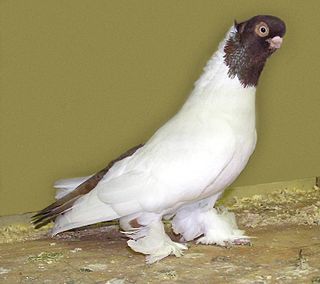
The Königsberg Colour-head Tumbler is a breed of fancy pigeon developed in the mid-18th century in Königsberg, East Prussia, from which it gets its German name. This breed of pigeon is well known in Russia because Königsberg is now a part of Russia, and is known as Kaliningrad.

German Nun is a breed of fancy pigeon bred by German pigeon fanciers. German pigeon-breeders have had great success in breeding German Nuns, which originated in the early seventeenth century. These birds are also widespread among the pigeon-breeders of Russia, where they are called Cross Monks. The breed got its name Monk from a colored cap on its head, and Cross from the colored tail and colored primary wing feathers, which resemble a cross during the pigeon's flight. The rest of the feathering is white.

The Archangel is a breed of fancy pigeon, notable for the metallic sheen of its feathers. Archangels, along with other varieties of domesticated pigeons, are all descendants from the rock pigeon. It is kept as an ornamental or fancy breed, valued for its unusual appearance. Archangels are small, weighing about 12 oz. They have unfeathered legs and dark orange eyes. They may or may not be crested. The body of the bird is bronze or gold with wings that are either black, white, or blue.

The English Short-faced Tumbler is a breed of fancy pigeon developed over many years of selective breeding. English Short-faced Tumblers along with other varieties of domesticated pigeons are all descendants from the rock pigeon. The English Short-faced Tumbler is one of the oldest breeds referred to in John Moore's book Columbarium: or, The pigeon-house; being an introduction to a natural history of tame pigeons, giving an account of the several species known in England, with the method of breeding them, their distempers and cures.

The Komorn Tumbler is a breed of fancy pigeon developed over many years of selective breeding. The breed has American and European varieties that are recognized as separate breeds at shows with classes catering for American Komorner Tumblers and European Komorner Tumblers. Originally bred for acrobatic flying as a tumbler pigeon, Komorners are seldom free-flown today, and exist only for exhibition in pigeon shows.

The Australian Performing Tumbler (APT) is a breed of fancy pigeon.

Tumbler pigeons are varieties of domesticated pigeons descendant from the rock dove that have been selected for their ability to tumble or roll over backwards in flight.
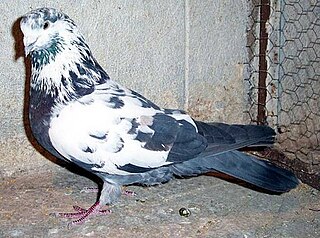
The Iranian Highflying Tumbler pigeon also known as "Persian Highflying Tumbler" in Europe and "Tehrani" in Iran is a breed of domestic pigeon bred in Iran for performance and endurance flying competitions. They fly at very high altitude and at times out of sight. The tumbling is nothing like a Birmingham Roller, individual flips, occasionally hovering before it does the flip.
The Kiev Tumbler is a breed of fancy pigeon.

The Parlor Roller is a breed of domesticated pigeon developed over many years of selective breeding. Parlor Rollers, along with other varieties of domesticated pigeons, are all descendants from the rock pigeon. The breed is known for its unique performance of turning somersaults on the ground. Parlor Rollers are considered to be further development from the Parlor Tumbler.
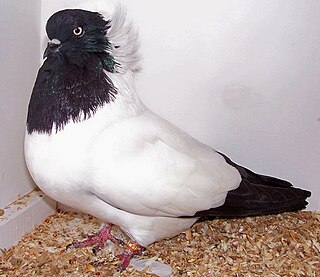
The Nun is a breed of fancy pigeon developed over many years of selective breeding, was also known as the Dutch Shell Pigeon in continental Europe. Nuns, along with other varieties of domesticated pigeons, are all descendants from the rock pigeon . The Nun is one of the oldest breeds and was originally a flying tumbler before being developed for exhibition. It is a mostly white breed, with a hood of feathers which gives the name to the breed.
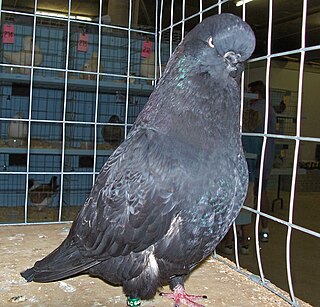
The English Long-faced Tumbler is a breed of fancy pigeon developed over many years of selective breeding. English Long Face Tumblers, along with other varieties of domesticated pigeons, are all descendants from the rock pigeon.

The Argenté rabbit is one of the oldest breeds of French show rabbits. The British Rabbit Council (BRC) recognises six varieties: Argenté Bleu, Argenté Brun, Argenté Crème, Argenté de Champagne, Argenté Noir, and Argenté St Hubert. The American Rabbit Breeders Association (ARBA) recognises the Champagne d'Argent and the Crème d'Argent. A rare variety, the Argenté Clair, is not currently recognised by either the BRC or ARBA.

The Berlin Long-faced Tumbler is a breed of fancy pigeon. Berlin Long-faced Tumblers, along with other varieties of domesticated pigeons, are all descendants from the rock pigeon.
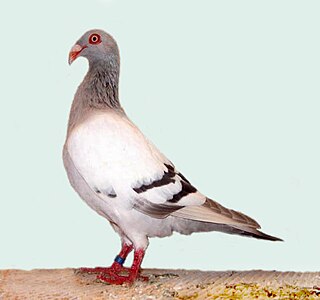
The Danish Tumbler is a breed of fancy pigeon. Danish Tumblers, along with other varieties of domesticated pigeons, are all descendants from the rock pigeon.
References
- ↑ Encyclopedia of Pigeon Breeds, by Wendell M. Levi. 1965
- ↑ van Grouw, Katrina (31 July 2018). Unnatural Selection. Princeton University Press. p. 64. ISBN 9780691157061 . Retrieved 18 August 2018.